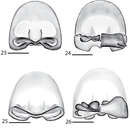Description
provided by Zookeys
Holotype female:Color: carapace red-brown, dusky near fovea and laterally; sternum orange-brown, darker around border; chelicerae dark-brown; maxillae orange-brown, lightening distally, darkening on anterolateral border, lightening on anteromedial border; labium orange-brown, lightening distally; abdomen dorsally brownish-grey with several medial chevrons, festoon present; ventrally dusky grey with no markings; legs orange to brown, darkening distally only slightly, annulations visible. Very dark and over half of tibiae, making lighter area appear very light. Cephalothorax: 0.83 times longer than broad; fovea longitudinal, broad, very shallow. Eyes:AER nearly straight; PER recurved; PME larger than AME, PLE largest, ALE smallest; eye diameters, AME 0.20, ALE 0.13, PME 0.30, PLE 0.55; interdistances AME-PME 0.03, PME-ALE 0.25, ALE-PLE 0.48. PME-PME 2.35. ALE-ALE 2.45; ocular quadrangle AME-AME 0.58, PLE-PLE 2.65; clypeus 0.07 high. Mouthparts:chelicerae with stout setae medially and anteriorly; maxillae longer than broad, with tuft of conspicuous setae distally; labium distally rounded. Sternum:1.38 times longer than broad, posteriorly indented. Pedipalp:claw with 12 teeth. Legs:leg I much shorter than legs II, III and IV; leg formula unknown (at least one leg missing); scopulae present on tarsi of all legs and metatarsi of legs I and II; tarsi I-IV with strong claw tufts; pr claw toothed, rl claws with fewer teeth; spination: leg I, Fm pr 1–1–1, d 1–1–1, rl 1–1–1; Ti d 0, v 2–2–2; Mt v 2–2; leg II, Fm pr 1–0–0, d 1–1–1, rl 1–1–1; Ti v 2–2–2; Mt v 2–2; leg III, Fm pr 1–0–0, d 1–1–1, rl 1–0–1; Ti v 2–2–0; Mt v 2–1. Abdomen:without terminal setal tufts. Epigyne:lateral lobes indistinct, hyaline median field with median septum terminating at heavily sclerotized posterior margin, lateral indentations directed anteriorly, posteromedian area u-shaped, genital openings located at posterolateral margins of median septum, internally ducts located posteriorly, directed laterally, branched, large heavily sclerotized posterodorsal fold covering nearly all of the internal ducts, medially depressed, rounded anterolaterally (Figs 25–26).Dimensions:Total length 9.33. Carapace length 4.73, width 5.75. Sternum length 2.75, width 2.00. Abdomen length 4.60, width 5.50. Pedipalp: Fm 1.00, Pt 0.70, Ti 0.75, ta 1.45, total 3.90. Leg I: Fm 4.75, Pt 2.00, Ti 4.00, Mt 3.00, Ta 1.00, total 14.75. Leg II: Fm 5.75, Pt 1.50, Ti 4.75, Mt 3.50, Ta 1.50, total 17.00. Leg III: Fm 5.80, Pt 1.75, Ti 4.75, Mt 3.75, Ta 1.00, total 17.05. Leg IV: Missing.
- bibliographic citation
- Crews S (2011) A revision of the spider genus Selenops Latreille, 1819 (Arachnida, Araneae, Selenopidae) in North America, Central America and the Caribbean ZooKeys 105: 1–182
- author
- Sarah C. Crews
Distribution
provided by Zookeys
The south central Mexican states of Morelos and Puebla (Map 5).
- bibliographic citation
- Crews S (2011) A revision of the spider genus Selenops Latreille, 1819 (Arachnida, Araneae, Selenopidae) in North America, Central America and the Caribbean ZooKeys 105: 1–182
- author
- Sarah C. Crews

